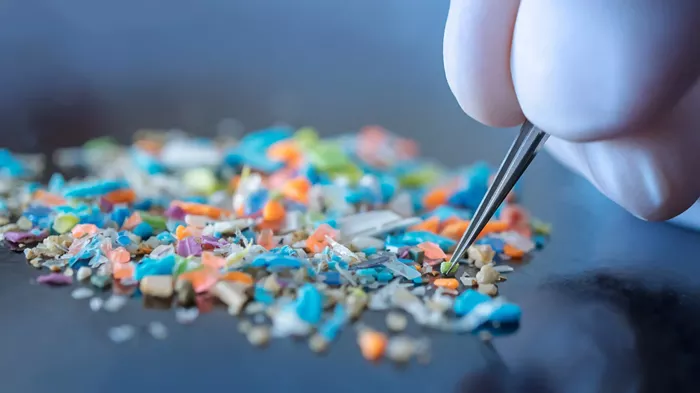In recent years, microplastics have emerged as a significant environmental and public health concern. These tiny plastic particles, measuring less than 5 millimeters in diameter, have infiltrated various ecosystems, food chains, and even the human body. The pervasive nature of microplastics, stemming from the widespread use of plastic products, raises alarming questions about their impact on human health. we will explores the effects of microplastics on the body, pathways into the human system, associated health risks, and potential preventive measures.
Background: Understanding Microplastics
What Are Microplastics?
Microplastics are small plastic particles that originate from the degradation of larger plastic items or are manufactured for specific industrial purposes, such as in cosmetics or cleaning products. They are categorized into two types:
Primary Microplastics: These are intentionally manufactured small particles used in products like exfoliants, microbeads in personal care products, or as abrasives in industrial processes.
Secondary Microplastics: These result from the breakdown of larger plastic debris due to environmental factors such as UV radiation, mechanical wear, and weathering. Common sources include plastic bottles, packaging, and synthetic textiles.
Sources of Microplastics in Daily Life
Microplastics are ubiquitous in modern life, finding their way into various consumer products and environmental settings:
Personal Care Products: Many cosmetics and toothpastes contain microbeads for exfoliation or polishing purposes.
Synthetic Textiles: Washing synthetic clothing releases microfibers into wastewater, which often ends up in oceans and rivers.
Plastic Packaging: The widespread use of plastic packaging contributes to microplastic pollution through degradation and improper disposal.
Automotive Tires: The wear and tear of tires on roadways release microplastic particles that accumulate in the environment.
Food and Beverages: Microplastics have been detected in various food items, particularly seafood, and even in drinking water.
Pathways into the Human Body
Ingestion
One of the primary routes of microplastic entry into the human body is through ingestion. Microplastics have been found in a variety of foods, including fish, shellfish, honey, and salt. Additionally, bottled and tap water can contain microplastic particles. Once ingested, these particles can accumulate in the gastrointestinal tract, where they may interact with the gut lining.
Inhalation
Microplastics can also be inhaled, particularly in urban environments where they are present in the air due to road dust, tire wear, and industrial emissions. Indoor environments are not exempt, as microplastic particles can originate from household dust, textiles, and various consumer products.
Dermal Exposure
Although less studied, dermal exposure to microplastics is another potential route. This can occur through the use of personal care products containing microbeads or through contact with contaminated water. The skin, being a barrier, may prevent some particles from entering the body, but prolonged exposure could still pose risks.
See also: Top 10 Foods That Cause Inflammation & How to Avoid Them
Health Impacts of Microplastics on the Human Body
Physical and mechanical damage
Microplastics, due to their small size and shape, can cause physical damage to tissues and organs. Once ingested, they may lead to inflammation and damage to the gastrointestinal lining. The sharp edges of certain microplastic particles can cause mechanical irritation, potentially leading to ulcers or other gastrointestinal issues.
Chemical Toxicity
Microplastics can act as carriers for toxic chemicals, including persistent organic pollutants (POPs), heavy metals, and additives like phthalates and bisphenol A (BPA). These chemicals, when released into the body, can disrupt endocrine function, mimic hormones, and lead to various health problems, such as reproductive disorders, metabolic issues, and developmental problems.
Oxidative Stress and Inflammation
Research suggests that microplastics can induce oxidative stress, a condition where the balance between free radicals and antioxidants in the body is disrupted. Oxidative stress can lead to chronic inflammation, which is a known precursor to numerous diseases, including cancer, cardiovascular diseases, and neurodegenerative disorders.
Immune System Disruption
The presence of foreign particles like microplastics in the body can trigger an immune response. The immune system may attempt to engulf and eliminate these particles, leading to chronic inflammation and potentially weakening the body’s ability to fight off infections and other diseases.
Potential Carcinogenic Effects
Although research is still in its early stages, there is concern that prolonged exposure to microplastics could have carcinogenic effects. The combination of mechanical damage, chemical toxicity, and chronic inflammation creates a complex environment that may increase the risk of cancer development.
Preventive Measures: Reducing Microplastic Exposure
Minimize plastic use
Reducing the use of single-use plastics is a crucial step in minimizing microplastic pollution. Consumers can opt for reusable alternatives, such as glass or metal containers, and avoid products containing microbeads.
Supporting Regulations and Policies
Advocating for and supporting policies that limit the production and use of microplastics can have a significant impact. Legislation banning microbeads in personal care products has already been implemented in several countries, and similar measures could be extended to other sources of microplastic pollution.
Improving Waste Management
Proper disposal and recycling of plastic products can help reduce the amount of plastic waste that breaks down into microplastics. Improved waste management practices, particularly in developing regions, are essential to mitigating the spread of microplastics in the environment.
Advancements in Filtration Technology
Developing and implementing advanced filtration systems in wastewater treatment plants can help capture microplastics before they enter natural water bodies. Similarly, household water filters can reduce the presence of microplastics in drinking water.
Raising Public Awareness
Education and awareness campaigns can inform the public about the sources and dangers of microplastics, encouraging behavior change and greater support for environmental protection initiatives.
Conclusion
Preventive measures, including reducing plastic use, supporting regulatory policies, improving waste management, and raising public awareness, are crucial to mitigating the risks posed by microplastics. As research continues to uncover the long-term effects of microplastics on human health, it is imperative that both individuals and policymakers take proactive steps to protect public health and the environment.
Related Articles:
What Are Some Natural Anti Inflammatory Foods?
Health Hazards Arising from Improper Food Handling Practices
Best Anti-Stress Supplements: A Comprehensive Guide


